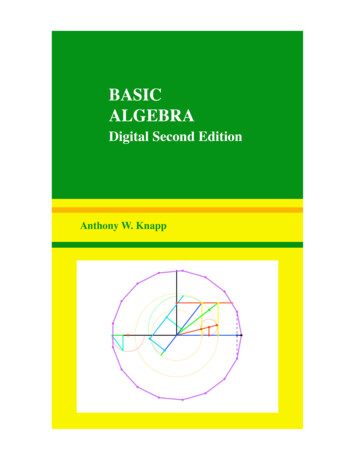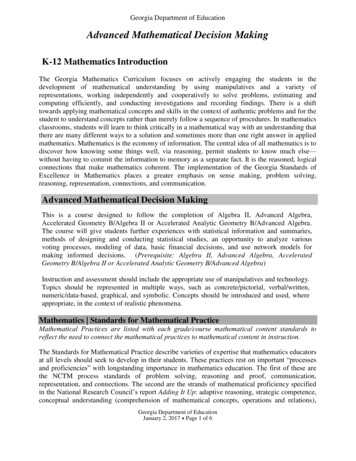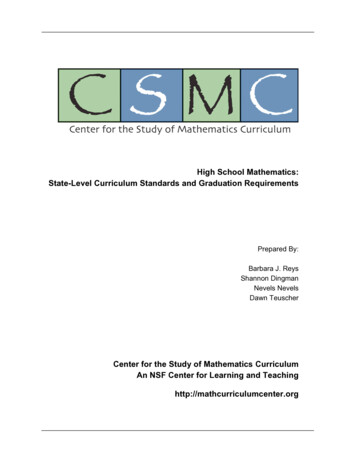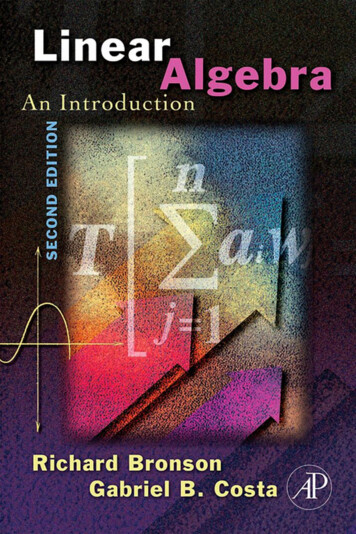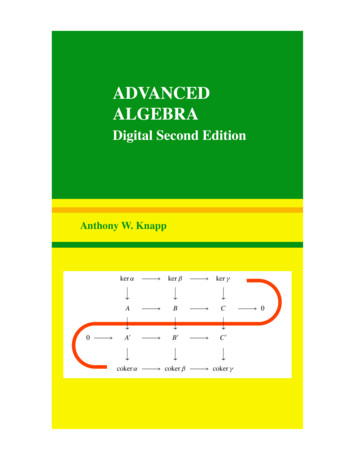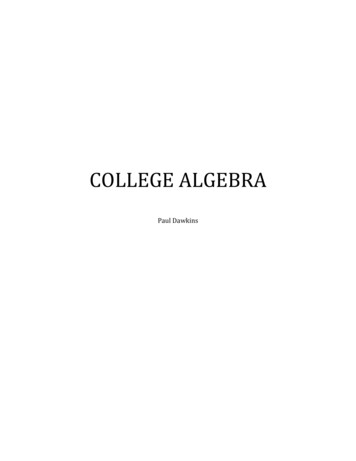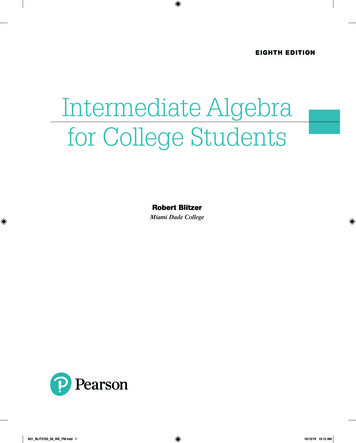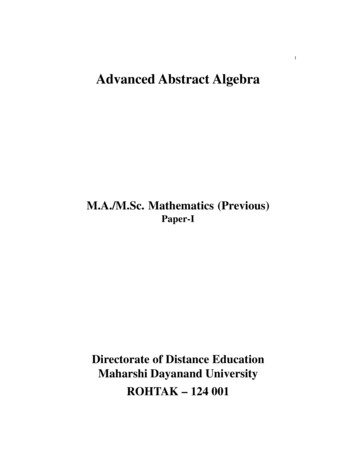
Transcription
1Advanced Abstract AlgebraM.A./M.Sc. Mathematics (Previous)Paper-IDirectorate of Distance EducationMaharshi Dayanand UniversityROHTAK – 124 001
2Copyright 2003, Maharshi Dayanand University, ROHTAKAll Rights Reserved. No part of this publication may be reproduced or stored in a retrieval systemor transmitted in any form or by any means; electronic, mechanical, photocopying, recording orotherwise, without the written permission of the copyright holder.Maharshi Dayanand UniversityROHTAK – 124 001Developed & Produced by EXCEL BOOKS PVT. LTD., A-45 Naraina, Phase 1, New Delhi-110028
3ContentsUnit I5Unit IIUnit III4962Unit IVUnit V76128
4ADVANCED ABSTRACT ALGEBRAMax. Marks : 100Time : 3 HoursNote : Question paper will consist of three sections. Section I consisting of one question with ten partsof 2 marks each covering whole of the syllabus shall be compulsory. From Section II, 10 questionsfrom each unit. The candidate will be required to attempt any seven questions each of five marks.Section III, five questions to be set, one from each unit. The candidate will be required to attemptany three questions each of fifteen marks.Unit IGroups, Subgroups, Lagrange’s theorem, Normal subgroups, Quotient groups, Homomorphisms,Isomorphism Theorems, Cyclic groups, Permutations, Cayley’s Theorem, Simplicity of An for n 5.Unit IINormal and Subnormal series. Composition Series, Jordan-Holder theorem, Solvable groups. Nilpotentgroups.Unit IIIModules, submodules, cyclic modules, simple modules, Schure’s Lemma. Free modules, Fundamentalstructure theorem for finitely generated modules over a principal ideal domain and its application tofinitely generated abelian groups. Similarity of linear transformations. Invariant subspaces, reduction totriangular forms. Primary decomposition theorem and Jordan forms. Rational canonical form.Unit IVRings, subrings ideals, skew fields, integral domains and their fields of quotients, Euclidean rings, polynomialrings, Eisenstein’s irreducibility criterian. Prime field, field extensions, Algebraic and transcendentalextensions, Splitting field of a polynomial and its uniqueness. Separable and inseparable extensions.Unit VNormal extensions, Perfect fields, finite fields, algebraically closed fields, Automorphisms of extensions,Galois extensions, Fundamental theorem of Galois theory. Solution of polynomial equations by radicals.Isolvability of the general equation of degree 5 by radicals.
UNIT-I5Unit-IGroupDefinitionA non empty set of elements G is said to form a group if in G there is defined a binary operation, called theproduct, denoted by., such that:1.a.b G a,b G (closed)2.3.(associative law) an elementsuch that a.e e.a a(the existence of an identity element in G)such thata.b b. a e (The existence of an identity element in G)Example 1:4.Leti.e. G is the set of nonsingular 2 2 matrix over rational numbers Q. 0e aG G, b G a.b G a,ba.b.ca.b.ac Ga , b, c G a aG11 a11a12 G12forms a group under matrix–multiplication. Infact, we note thata A , :aij Rational numbers Q,det( A) 0Ga21 a21a22 a22a11 a12b11 b12, b 1. Let a aabb be two non-singular 2 2 matrices over Q.fg( 11ge2) bRgFb gIJ IFGSHGH KJKTFGH2122UVWIIJ FK GH JK2122Now a.b under matrix multiplication is again 2 2 matrix over Q and det (a.b) (det a) (det b) 0 , asdet a, det b.2.3.4.We know that matrix multiplication is always associative. Therefore,ba.bg.c a.bb.cg a,b, c GF1 0I e G J I G suchthat a. I I . a a a G0 1KHIf a G , say 1we get a then1a11a22 a21a12baFGgH a2221 a12a11IJK
6ADVANCED ABSTRACT ALGEBRAF 1 adjbgIa J I eGaHdetbgKa.a 1 a.similarly a 1 . a I e a 1 GThus G is a group.Note that a.b b. a a , b G . Infact, letbut a.b 11 7 IFF8 13I G J b. aGJH3 2K H3 5 KDefinitionA group G is said to be abelian (or commutative) if a.b b.a. a, b G.Therefore, example 1 gives us a noncommutative group with infinite number of elements in it, since elementsare taken from Q, rational numbers which are infinite.DefinitionThe number of elements in a group G is called the order of G. Denote it by O (G). When g has finite numberof elements, G is a called a finite group.Example 2:G R1 0I F 1 0 I F0 1I F0 1IUF,G, G J,GSGJJKVTH0 1KH0 1KH1 0KH 1 0 JWG is again a set of 2 x 2 matrices with entries in Z , integers, but containing only four elements.1 0I0 1IFF 1 0 IJ, b FF0 1IJ,a G,c GGJGJH0 1K H0 1K H1 0K H 1 0 KF1 0Iwe can verify a b c e G J I ,0 1KHLet e 222and a b c ba, ac b ca, bc a cb.it can be easily verified that G is a group under matrix multiplication. Thus G is an abelian group containingfour elements only (Note that entries are from Z).Therefore, G is a finite abelian group.Remarks:In this example every element of G is its own inverse i.e. a a-1, b b-1, c c-1, e e-1.a
UNIT-I2.71 1I8 5IFFGJGH K H JK2 5I F5 13IF1 1I, F G JGJ GJ 2 8 K H 3 8 K0 1 KHHF2 7 IJ ba.bg GH 3 11KIn example 1, a 0 1 , b 3 2 ,Note that a 1 b 1 13.In a group G, we can prove that (a b)-1 b-1 a-1 a , b G ,ba bgdb 1i d ia 1 a b b 1 a 1 a e a 1 a 1 eSimilarly (b-1 a-1) (a b) e.Hence (a b)-1 b-1 a-1This rule can be extended to the product of n elements, we note thatba a12a3 ang a 1 1nan 11 a2 1 a1 1ba G,1 i ng,iExample 3:If every element of a group G is its own inverse (i.e. a2 e for all a G), then G is abelian. We note thatax2, ye Ga. a ae , thena ax 1 aan , Gy a m , n, m Z , Nowand a,b G,b g bΘ a b G gab a b 1 b 1 a 1 b a.Definition:A group G is said to be cyclic if every element of it is a power of some given element in it. This given elementis said to generate or a generator of the group G. Thus G is cyclic if a G such thatnsnx a n , n Z , x G. It is denoted by G a a : n Z ,Remarks 1:A cyclic group is necessarily abelian but the converse is not true.Letxy a n a m a n m a m n a m a n yx x, y G.Thus a cyclic group G is abelian. But example 2 shows that every abelian group is not cyclic. Every elementof G in example 2 can not be written as power of either a, b or c in it, verify it.
8ADVANCED ABSTRACT ALGEBRAProblem 1:Let G be a non empty set closed under an associative product, which has left indentity e and left inverse forall elements of g. show that G is a group.Proof:Let a Gand let bsuch that b a e. Nowb a b (b a) b e b b .(i)such that c b eHence c (b a b) cb e from (i)bcbgba bg eab e b is also right inverse of a.Further,a e a (b a) (a b) a e a aHence e is right identity alsoThus G is a group,SubgroupsLet H be a non-empty subset of the group G such that1.2.a 1 Hb a ΘZ a HWe prove that H is a group with the same law of composition as in G.Proof:H is closed under multiplication from (1). All elements of H are from G and associative law holds in G,therefore, multiplication is associative in H also.Let a H , then a-1from (2) and so from (1), a a-1, i.e. e a a-1.which implies, identity law holds in H, (2) gives inverse law in H. Thus H is a group. H is called a subgroupof G. Thus a nonempty subset of a group G which is a group under the same law of composition is called asubgroup G. Note that e, the identity element G is also the identity of H.A group G is called nontrivial if G (e). A nontrivial group has at teast two subgroups namely G and (e).Any other subgroup is called a proper subgroup.Definition:Let b, a G, b is said to be Conjugate of a G, ifsuch that b x-1 ax.Problems:1.Let a G, let CG(a) {x G: x-1 ax a}Prove that CG(a) is a sbgroup of G.2.3.is a sub group of G.Find the centre of the group GL (2, R) of nonsingular 2 x 2 matrics over real numbers,
UNIT-I9Solutions:bgCG a φ , because e CG(a).1.CG(a). ThenLet x,yd i adx i x a x xdx ax ixahcΘ x C bg dx x i adxx iAlso, x 1 1 1 1 1 1 1bgG 1 e ae ax 1 CG abg bbgbgbgbggbgd i bgRemarks:x axiy y dso C (a) is the set of all elements of G commuting with a.ah y ay cΘ x C bgwe call C (a), the centralizer of aah a cΘ y C bgG . From abovexy C bga2. Let x, y Z bg 11Za xxy, y1GCZayGCG, yxaa 1 hencexa-1, x yCG(a), hence CG(a) is subgroup of G a ax, axx C Ga ,1 Gxyxxy,Ga ThusGaΙxa G 1 1 1GGGGGhenceThus Z (G) is a subgroup.Note thatDefinitionZ (G) is called the center of the group G.3.let x a bIFGHc d JK centre of GL (2, IR) x commutes with all non-singular 2 x 2 matrices, So in particular x commutes with
10ADVANCED ABSTRACT ALGEBRA1 1I F1 0IF, G J GL bGJH0 1K H1 1K 2, IRgF1 1I Fa bI F1 1I Fa a bIJ . (1)xG J G J G J Gc c dK0 1K HH0 1K Hc d KH1 1IFF1 1I Fa bI Fa c b d IJ . (2)x G JG J GGJc d K Hcd K0 1K H0 1KHH(1) and (2) givesa a bIFFa c GGJHc c d K Hcb ddIJKHence c 0, a dSimilarly,givesb 0.Therefore x a 0IFGH0 aJK, where a o, a Ris a scalar matrix and so commutes with all 2 x 2 matrices, (nonsingular or not) Hence Z (GL(Z,R), thecenter of GL (2, R) Consists of all nonzero scalar matrices.Remark:This can be generalised that the center of GL (n, R), the general linear group of nonsingular n n matricesover IR, consists of all nonzero scalar matrices.Coset of a subgroup H in G:Let G be a group and H be a subgroup of G. For any a G, Ha {ha / h H}. This set is called right cosetof H in G. As e H, so a e a Ha. Similarly aH {ah / a h} is called left coset of H in G, containing a.Some simple but basic results of Cosets:Lemma 1: Let H be a subgroup of G and let a, b G.Then1. a Ha2. Ha Ha H3.Either two right cosets are same or disjoint i.e. Ha H b or4.Ha H b5.b a-1 Hi.e. there is one-one correspondence between two right CosetsProof:1.a e a Ha2.Let, Now hbΘ e H gdue to closure in H.FGH a H Hx
UNIT-I11 Ha H. To showWe get a-13. Hence h he h (a-1 a)and h a-1 (h a-1)aHa Hlet h be any element of H.Sincea. Soea. Thus H Ha.a.SupposeThen x h1a and x h2 b, for some h1, h2 H ,Thus4.Ha Hb H H ba 1 b a 1 H , from (2)5.Define f : Ha Hb by ha hb h H . f is one-one, By definition it is obvious that f is onto.We again visit example 2, G {e, a, b, c}d bi g b g bg d bi g b g d i d ibgNow we are ready to prove a theorem called Lagrange's, Theorem.bgTherethreeof 1G, H1 {e,a}, H {e, b}, H3 {e, c}order of each Hi, i 1, 2, 11 1 Hb HH,H hHaφb 12 hlet are. hhHaHaHah H hHaG Hb , 1proper subgroupsG Thenf .hx,2 afromh1Hb h1 bb 1 h2 2bb 1h2 e h2 eh1e a Hh,Ha1f h 2b Haaa H2rb1 h2 bh1b b h2b b2 1ha11 x12 b and3, is 2. Hence O (Hi) O (G) 4. ie. /Hi/ divides /G/.H h2 e a h1 a h2 aTheorem 1. Lagrange's Theorem (1770): /H/ divides G .If G is a finite group and H is a subgroup of G, then /H/ divides /G/. Moreover, the number of distinct right leftcosets of H in G is.Proof:Since G is a finite group, we have finite number of distinict right cosets of H in G, say Ha1, Ha2,., Har.Now for each a in G, We have Ha Hai for some i. By property (i) of Lemma 1, a Ha. Hence, eachelement of G belongs to one of Cosets Hai, i.e.By property (3) of lemma 1,Hai Ha j φ ,for i j. G Ha1 Ha2 . H ar for each i.(Because f : H Hai defined by h haiis one-one & onto).
12ADVANCED ABSTRACT ALGEBRATherefore we getG H H H r timesi. e. G r HWarning:Let G be a finite group of order 12. We may think that it has subgraps of order 12, 6, 4, 3, 2, 1 but no others.Converse of Lagranges theorem is false. 6 12 but there exists a group of order 12 which does not have asubgroup of order 6. We shall give this example some time later.The number of right (or left) cosets of a subgroup H in a group G is called the index of a subgroup H in thegroup G. This number is denoted by /G:H/. When G is finite, by Lagrange's theorem, we have G: H GH.We can say:G H index of H in G.Corollary 1:a dvides GIn a finite group, the order of each element of the group divides the order of the group.Proof:b ga 0 a order of the subgroup generated by ,Corollary 2:aGaaLeGroups of Prime order are cyclic.Proof:dividesch.chbut o a 1and G is prime. Hence o a G.Therefore a GG a ie. G is cyclic.Corallary3:a G e.let G be a finite group, and leta G . ThenProof:G a n, n is a positive integer, by Corollary 1.Hence a G a a nej aan en eHence the corollary.
UNIT-I13Corollary 4: (Feremat's Little Theorem):For every integer a and every Prime p, ap a (mod p).Proof:By division algorithm, a pm r, 0 r p. Hencea r (mod p). The result will be proved if we prove rp r (mod p). If r 0, the result is trivial. Hencewhich forms a group under multiplication module o p. Therefore by corollary 3,p-1pr 1. Thus r r (mod p).Normal SubgroupsIf G is a group and H is a subgroup of G, it is not always true that aH Ha,Definition:A subgroup H of a group G is called a normal subgroup of G if a H Ha for every a in G. This is denotedby H G.Warning:H G does not indicate ah haH G means that if,then some h1 H such thatA subgroup H of G is normal in G if and only if x Hx 1 H x G.d ib g b g b g icb gb gh d Habb cg Ha(orbb cgh Hagroups):cHquotientcbH bgbHcgh a,b, c G.Factorgroups 1 1 p a GxH aHx x G and { 1hG,G.,. 3,.1}H Hx abhr ah H a,Hb a1 G HΘ. 1xHx h1 HcHaHab12x Hx x H x HHc, hence Hx HcxH Hx Gb) cLet H g. The set of right (or left) cosets of H in G is itself a group. This group is called the factor group ofG by H (or the quotient group of G by H).Theorem 2:Let G be a group and H a normal subgroup of G. The set G H { Ha a G } forms a group under theoperation (Ha) (Hb) Hab.Proof:We claim that the operation is well defined. Let Ha Ha1 and Hb Hb1.Then a1 h1a and b1 h2b, h1, h2 H.Therefore, Ha1b1 Hh1 ah2b Ha h2b aHh2b aHb Hab(In proving this we used Ha HaH and H G).Further He H is the identity and Ha-1 is the inverse of Ha, a(Ha) (He) Hae Ha, and Ha Ha Ha a He H,-1-1G.
14ADVANCED ABSTRACT ALGEBRAThusis a group.Theorem3:Theorem.Let G be a group and let Z (G) be the center of G. Ifis cyclic, then G is abelian.Proof:we claimbg bgwe show that g 1 Z G g Z G g G.bgg xg g bx gg g bg x gcΘ x Z bgGh dg gix ex x Z bgGHence g xg Z bgG g G , x Z bgGlet x Z G , then 1 1 1 1 1bg bgTherefore, g 1 Z G g Z G g G .We can now form a factor groupFΘ G is cyclicIJGbg bgGH ZbgKLet G Z G x / gGGZaZab Let a,b G. To show ab bahenceGbg c bgh x Z bgand bZ bgG cxZ bgG h x Z bgG , where n, m are integers.Thus a aZ bgGa x y for some y Z bgGand b x t for some t bgGaZ G xZ GnnmmnmNow baWe often use it as: If G is not abelian, thenis not cyclic.
UNIT-I15Definition: Group Homomorphismbe a mapping from a group G to a groupLetdefined by:Gab g bgbgf ab f a f b a , b G.f is called homomorphism of groups.Definition: Kernel of a HomomorphismLet:Gbe a group homomorphism anddenoted by KerKerbe the identify ofis defined by homomorphismGKerWe note that kerG. (It is easy to show that ker f is a subgroup of G)bg(db )ig(bgbgbgdWer ishowmd i bgthatΘ 11 a G , SatisfyingGeG gxfffx 1ag kerxgG,xgf: f(f x g)xee (1 xfker)f Θgxf f,f G(xg) Gf andgGf kergexf g 1 eeisf theg , identifyΘ x keroff GLet x be any element of ker).Thend i bg d i bΘ f ishomomorphismgf g 1 f g f g 1 gbg f e e( Any homomorphism of groups carries identity of G to identity ofExplanation: f ( xe ) f ( x ) f (e ) in GSo by cancellation property in, we have (e).)Henceg 1 xg ker f g G , x ker fker f G). Then Kernel of
16ADVANCED ABSTRACT ALGEBRALemma 2:Letbe a homomorphism of G into1.(e) , then, the identify element of2.( )f x n ( f ( x )) x G3.nProof :(1) is proved abovebg d i bgd ie f e f x x 1 f x f x 1(2)(f (x )) 1 e (f (x )) 1 f (x )f (x 1 ) inG(f (x )) 1 e f (x 1 ) f (x 1 ), x GExample 4:G GL (2, R): group of nonsingular 2 2 matrices over reals and R* be the group of nonzero real numberunder multiplication. Thenf: G GL (2, R)AThenR* defined by(A) det A(AB) det (AB) det A det B Hence(A)ff f(eGA (B)is a homomorphism A SL(2, R ), the group of nonsingular 2 2 matrices over R, whose determinant is 1. Therefore,kerTheorem 4: (Fundamental Theorem of Group Homomorphism)Lef:Gbe a group homomorphism with K kerG f (G)ki.e.Gker( f ) Image ( f )( : Isomorphic, whenis homomorphism, 1–1 and onto). Then
UNIT-I17Proof:Consider the diagramfGwhereThe above diagram should be completed tofGfWe shall useGφf (g ) KgGKf (g )gfKgto complete the previous diagram.Define f (kg ) f (g )s coset Kg G Kf is well defined: Let Kg 1 Kg 2 , g 1 , g 2 GThen g 1 kg 2 , k ker (f ) K , andf (g1 ) f (kg 2 ) f (k ) f (g 2 ) e f (g 2 ) f (g 2 )is a homomorphism since()f Kg 1 Kg 2 f (Kg 1g 2 ) f (g 1g 2 ) f (g1 )f (g 2 )(Θ f is a homomorphism).
18ADVANCED ABSTRACT ALGEBRAf is 1–1 since f(kg 1 )( )f ( g 1 ) f (g 2 ), hence f (g 1 ) f g 2 1 f(kg 2 ) 1 e and f ( g1 g2 ) e (Θ f is a homo).So g 1 g 2 1 K ker f , which shows that kg1 kg 2 . Thusis 1–1. By definition f is onto. Hence f ishomorphism. So G k f (G ) G .Consider Again Example 4:f : GLn (R ) GL(n, R)R*Af ( AB ) det ( AB ) det ( A )det (B )Sois a homomorphism.the identity of R*. A SLn (R ) SL (n, R ), the subgroup ofBy above fundmental homomorphism theorem, we getGL (n , R ) Im( f )ker fi.eGL(n , R ) Im( f )SL(n , R )But f is onto, since forA Hencea1101.10 GL(n , R ) such that f ( A) det A an nGL(n, R ) R*SL(n, R )Theorem 5 (First Isomorphism Theorem)Let G be a group with normal subgroup N and H such that N HThenandof all n n matrices with determinant 1.ffG AHa
UNIT-I19(G N ) G(H N ) HDefine f : G NNabyHais well-defined, since Na Nbforwe get. Since N H , thus givesand soHa Hb. f is a homomorphism:the identity of Ha H a HHence ker. As ker f G N , so H N G NThe fundamental homomorphism theorem for groups implies thatGNker f Im f GN a(bHNaG N, a )kerGHNaf ,( 1aNa bfNNb HfH) , fNNaNb(fNab(Na ) f (HabHa ),f (b ) HaHb a, bf ( NaH ) f ( Nb )HNHaker,Nab a bH NN (H N ) GNH a N and a H N GHHN a H NTheorem 6 (Second Isomorphism Theorem)Let G be a group, and let N G , let H be any subgroup of g. Then HN is a subgroup of G,Proof:Define f:Hby ais a homomorphism sincea ker f f (a ) N , the identity element of HN and a HSoand
20ADVANCED ABSTRACT ALGEBRAThe arbitrary element ofHNis NaN but a H G andN, so aN Na, hence NaN NNa Na.Therefore, f is onto. Now by fundamental homomorphism theorem for groups, we geti.e.HH N HNNSome results about cyclic groups: we prove the following results:Theorem 7:Let g be a cyclic group1.If G is infinite, then G Z2.Ifthen G Z n Proof:1.Let g a be infinite cyclic group.Define f : Zg by n.f is a homomorphism, sincef is onto: since G a , so for anywe get x a m for some integer m,Hence f (m ) a m xf is onto f is 1–1: LetThen multiplying by, we get a m n e and since a is not of finite order, we must have m n.for m, n z, withHence every infinite cyclic group is isomorphic to additive group of integers.2.Let G be a finite group with n elements,zDefine f :G by [m] n f is well-defined. We should show that ifthenwhere a has finite order n.a k a m a k m e n (k m) k m(mod n )f is onto, since G a .is 1–1: letthen as aboveAlso f is an isomorphism. Hence every finite cyclic group of order n is isomorphic to additive group of integersmudule n.(mffamxGakaNH
UNIT-121Theorem 8. Let H be a subgroup of a cyclic group a and m is the least positive integer such that am H. If an H , then m n.Proof. By division algorithm, we haven qm r, q, r Z , 0 r mTherefore,Ar an qm an(a qm) an (aqm) 1 HHence r 0 , otherwise it will contradicts the fact that m is the least positive integer such that m is theleast positive integer such that am H. Thereforen qmand so m n . This completes the proof.Let G a be a cyclic group generated by a. Then a 1 will also be a generator of G. In fact, if am G, m Z , thenam (a 1) mThe question arises which of the elements of G other than a and a 1 can be generator of G. We considerthe following two cases :(i)g is an infinite cyclic group(ii)G is a finite group.We discuss these cases in the form of the following theorems :Theorem 9. An infinite cyclic group has exactly two generators.Proof. Let a be a generator of an infinite cyclic group G. Then a is of infinite order andG { , a r , , a 1, e, a, a, , ar, .}Let at G be another generator of G, thenG { , a 2t, a t, e, at, a2t, .} .Since at 1 G, thereforeat 1 art for some integer r.Since G is infinite, this impliest 1 rt(r 1)t 1which holds only if t 1 1. Hence there exist only two generators a and a 1 of an infinite cyclic group a .Theorem 10. Let G a be a cyclic group of order n. Then am G, m n is a generator of G if andonly if g c d (m, n) 1.Proof. Let H be a subgroup of G generated by am(m n).integers u, v such thatum vn 1aum vn aaum . avn a(am).(an)v a(am)u a (Θ (an)v e)a H (Θ (am)u H)G H.But, by supposition, H G.Hence G H am , that is, am is a generator of G.Conversely, let am (m n) be a generator of G . ThenG { amn : n Z ) .Therefore, we can find an integer u such thatIf g c d (m,n) 1, then there exist two
ADVANCED ABSTRACT ALGEBRA22amu aamu 1 eO(a) (mu 1)n (mu 1)Hence, there exists an integer v such thatnv mu 1mu nv 1gcd(m, n) 1 .This completes the proof of the theorem.Theorem 11. Every subgroup H of a cyclic group G is cyclic.Proof. If H {e}, then H is obviously cyclic. So, let us suppose that H {e}. If aλ H , then a λ H.So, we can find a smallest positive integer m such that am H. Therefore am H(i)Moreover,Thereforeaλ Hλ qm, q Zaλ aqm (qm)q am aλ am H am (ii)It follows from (i) and (ii) thatH am And hence H is cyclic.Theorem 12. Let G a be a cyclic group of order n and H be a subgroup of G generated by am, m n. ThenO(H) ngcd(m, n )Proof. We are given thatH am Let gcd(m,n) d, then we can find an integer q such thatm qdam aqdqddBut a a , where ad is a subgroup generated by ad. Therefoream ad H am ad .Since gcd (m, n) d, we can find u, v Z such thatd un vmad aun vm aun . avm avm (Θ aun e)vmmBut a a H . Thereforead Hd a H .(ii)(i)
UNIT-123From (i) and (ii), we haveH ad O(H) O( ad )ButO ( ad ) nd(Θ (ad)n e)dHenceO(H) n,gcd(m, n )which completes the proof of the theorem.Theorem 13. Any two cyclic groups of the same order are isomorphic.Proof. Let G and H be two cyclic groups of the same order. Consider the mappingf:G Hdefined byf(ar) brThen f is clearly an homomorphism. Also,f(ar) f(as)br bs ,If G and H are of infinite order, thenr srsand so a a .If their order is finite, say n, thenbr s eBr bsn (r s)nu r s ,u Zr snua a (an)u ear as .Hence f is 1 1 mapping also. Therefore, G H.Theorem 14. Every isomorphic image of a cyclic group is again cyclic.Proof. Let G a be a cyclic group and let H be its image under isomorphism f. The elements of Gare given byG { , a r, , a 3, a 2, a 1, a, a2, a3, , ar, }Let be an arbitrary element of H. Since H is isomorphic image of G, there exists ar G, r 0, 1, .Such that b f(ar). Since f is homomorphism, we haveb f1(a4).4f (2b).f (c )4 43r factors (f(a)rThus H is generated by f(a) and hence is cyclic.
24ADVANCED ABSTRACT ALGEBRAPermutations:Let S be a non-empty set/ A permutation of a set S is a function from S to S which is both one-to-one andonto.A permulation group of a set S is a set of permutations of S that forms a group under function composition.Example 5:LetDefine a permutation σ byThis 1–1 and onto mappingcan be written asDefine another permutationφ(1) 3 , φ(3 ) 2 , φ(2 ) 1, φ(4 ) 4(σσSφσφThenφσ 1 2 3 41 2 3 43 1 2 42 3 4 11 2 3 41 2 4 3The multiplication is from right to left.Wesee (φσ )(1) φ(σ(1)) φ(2) 1,and.Example 6: Symetric GroupsLet S 3 denote the set of all one-to-one function from {1, 2, 3} to itself. Then S 3 is a group of six elements,under composition of mappings. These six elements aree 1 2 31 2 3,α 1 2 32 3 1,α 2 1 2 33 1 2
UNIT-I25Note that αβ 1 2 31 2 3 βα3 2 12 1 3Hence S 3 , the group of 6 elements, called symmetric group which is non-abelian. This is the smallest finitenon-abelian group, since groups of order 1, 2, 3, 5 are of prime order, hence cyclic and, therefore, theyare abelian. A group of order 4 is of two types upto isomophism, either cyclic or Klein 4-group, given inexample 2.Cycle NotationLet σ 1 2 3 4 5 63 4 1 6 5 2This can be seen as:521σσσ)2, ( 23σSHA331 6)2}),)(H13233 3 )}{2e, (23)1} 2 31{{ee,)(,(122(123[S 3 : A3 ] , αβ2, β,,α β 3 2 12 1 31 3 A23σ64In cycle notation σ can be written asTherefore from example 6:It has 4 proper subgroups:andso A3 is a subgroup of S 3 of index 2. It can be easily verified that A3 S 3 . Infact, it canbe generalised, that every subgroup of index 2 is a normal subgroup in its parent group.group.is called alternating
ADVANCED ABASTRACT ALGEBRA26Example. Let1 2 32 3 1α and β 1 2 33 1 2be two permutations belonging to S3. Thenαo β 1 2 31 2 3o2 3 13 1 2 1 2 31 2 3 1 2 31 2 3andβ oαThus αoβ βoα . Hence α and β commute with each other.But the composition of permutations is not always commutative. For example, if we considerα 1 2 31 2 3, β 3 2 12 3 1thenβ oα 1 2 31 3 2αoβ 1 2 32 1 3andHenceαoβ βoα .Definition. Let S be a finite set, x S and α Sn . The α fixes x if α(x) x otherwise α moves x.Definition. Let S {x1, x2, , xn} be a finite set. If σ Sn is such thatσ(xi) xi 1 , i 1,2, , k 1σ(xk) x1andσ(xj) xj , j 1, 2, ., k;then σ is called a cycle of length k. We denote this cycle byσ (x1x2, , xk)Thus, the length of a cycle is the number of objects permuted.For example,a b c S3 is a cyclic permutation becauseb c af(a) b , f(b) c, f(c) a.
UNIT-127In this case the length of the cycle is 3. We can denote this permutation by (a b c).Definition. A cyclic permutation of length 2 is called a Transposition.For example,1 2 3is a transposition.1 3 2Definition. Two cycles are said to be disjoint if they have no object in common.Definition. Two permutations α, β Sn are called disjoint ifα(x) xβ(x) xα(x) xβ(x) xfor all x S.In other words, α and β are disjoint if every x S moved by one permutation is fixed by the other.Further, if α and β are disjoint permutations, then αβ βα. For example, if we considerα 1 2 31 2 3, β 2 3 11 2 3then αβ βα .Definition. A permutation α Sn is said to be regular if either it is the identity permutation or it hasno fixed point and is the product of disjoint cycles of the same length.For example,1 2 3 4 5 6 (1 2 3) (4 5 6)2 3 1 5 6 4is a regular permutation.Theorem 15. Every permutation can be expressed as a product of pairwise disjoint cycles.Proof. Let S {x1, x2, , xn} be a finite set having n elements and f Sn. If f is already a cycle, we arethrough. So, let us suppose that f is not a cycle. We shall prove this theorem by induction on n.If n 1, the result is obvious. Let the theorem be true for a permutation of a set having less than nelements. Then there exists a positive integer k n and distinct elements y1; y2, , yk in {x1, x2, , xn}such thatf(y1) y2f(y2) y3 . .f(yk 1) ykf(yk) y1Therefore (y1 y2 . yk) is a cycle of length k. Next, let g be the restriction of f toT {x1, x2, , xn} {y1, y2, , yk}Then g is a permutation of the set T containing n k elements. Therefore, by induction hypothesis,g α1α2 αm ,where α1, α2 , , αm are pairwise disjoint cycles. But
ADVANCED ABASTRACT ALGEBRA28f (y1 y2 yk) o g (y1 y2 . yk) α1 α2 αmHence, every permutation can be expressed as a composite of disjoint cycles.For example, letf 1 2 3 4 5 6 7 8 96 4 7 2 5 1 8 9 3be a permutation. Here 5 is a fixed element. Therefore, (5) is a cycle of length 1. Cycles of length 2 are(1 6) and (2 4) whereas (3 7 8 9) is a cycle of length 4. Hencef (5) (1 6) (2 4) (3 7 8 9)Theorem 16. Symmetric group Sn is generated by transpositions, i.e., every permutation in Sn is aproduct of transpositions.Proof. We have proved above that every permutation can be expressed as the composition of disjointcycles. Consider the m-cycle (x1, x2, , xm). A simple computation shows that(x1 x2 . xm) (x1 xm) . (x1 x3) (x1 x2),that is, every cycle can be expressed as a product of transposition. Hence every permutation α Sn canbe expressed as a product of transpositions.Remark. The above decomposition of a cycle as the product of transposition is not unique. Forexample,(1 2 3) (1 3)(1 2) (3 2) (3 1)However, it can be proved that the number of factors in the expression is always even or always odd.Definition. A permutation is called even if it is a product of an even number of transpositions.Similarly, a permutation is called odd if it is a product of odd number of transpositions.Further,(i)The product of two even permutations is even.(ii)The product of two odd permutations is even.(iii)The product of one odd and one even permutation is odd.(iv)The inverse of an even permutation is an even permutation.Theorem 17. If a permutation is expressed as a product of transpositions, then the number oftranspositions is either even in both cases or odd in both cases.Proof. Let a permutation σ be expressed as the product of transpositions as given below:σ α1α2 . αr β1β2 βsThis yieldse α1α2 αr βs 1 β r 11 β1 1 α1α2 αr βsβs 1 . β2β1 ,since inverse of transposition is the transposition itself. The left side, that is, identity permutation is evenand therefore the right hand should also be an even permutation. Thus r s is even which is possible if rand s are both even or both odd. This completes the proof of the theorem. p
6 ADVANCED ABSTRACT ALGEBRA „ 1 0 det, det a bgadjb agcQ b ag h a a a a. . adj a I e det- F HG I 1 KJ 1bg bg similarly a a I e a G-- \ 1 1. Thus G is a group. Note that a.b „ b.a "a,b G. Infact, let a b a b G F HG I KJ F HG I KJ 1 1 0 1 8 5 3 2, , , but a.b
